Eliminate Paper Clutter Forever with the KonMari Method of Decluttering
This post may contain affiliate links for your convenience. That means that if you make a purchase, I will receive a small commission at no extra cost to you. Read more here.
Notebooks and Post-its and bills, oh my! If you have been swimming through an endless sea of paper and feel as if you are about to drown, let me throw you a life preserver! The KonMari method is here to help you eliminate paper clutter — permanently. See the exact steps you can take to get rid of paper clutter and start getting your life in order.
Why you should declutter paper KonMari-style
Marie Kondo’s decluttering method isn’t just a method; it’s an entire philosophy. According to Marie Kondo herself:
The approach is rooted in a single question: Does this item spark joy? Identifying what sparks joy leads to a tidy home filled only with items you cherish. It’s also a path to self-discovery, mindful living and fulfillment.
That’s what makes the KonMari method so special.
You see, whereas most other minimalist philosophies focus on the getting rid of part, the KonMari Method is all about mindfully choosing to keep things that spark joy.
By focusing on what to keep rather than on what to discard, the process becomes positive and empowering. You might even experience grand moments of self-discovery while tidying up!
(Indeed, it’s not called The Life-Changing Magic of Tidying Up for nothing; it has literally changed my life and helped me move on after decades of grief.)

Why does Marie Kondo put paper third?
In her fantastic book, The Life-Changing Magic of Tidying Up: The Japanese Art of Decluttering and Organizing, Marie Kondo stresses the importance of following an exact progression of tidying categories in her book.
These are:
- Clothing
- Books
- Paper
- Komono (Miscellany)
- Mementos
Her reasoning? Starting with items you have the least amount of attachment to you increases your probability of success in letting go as you move towards more difficult categories.
Paper in the third spot perplexed me…after all, how does one get attached to paper?
Paper schmaper, I thought to myself, rubbing my hands together and cackling like the Wicked Witch of the West.
After all, who cares about paper?
It’s not like books you read and consider to be old friends. Or photographs of loved ones or souvenirs from travels.
Psssh, how hard can tidying paper be?
Reader, oh how wrong I was!!!
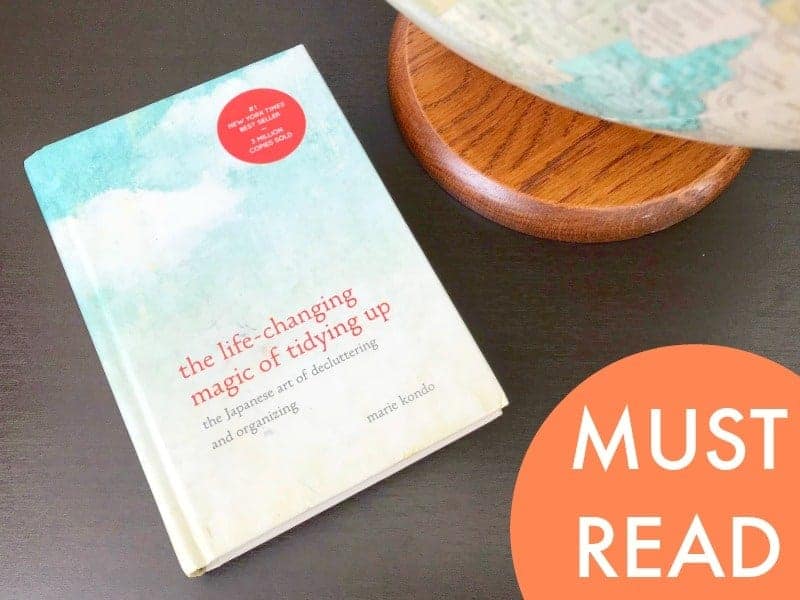
It wasn’t until I found myself in tears over paper that I got it.
- Old notebooks with humorous quotes from professors scrawled in the margins.
- Drawings given to me by the children I taught at school.
- Binders stuffed to the brim with syllabi and old school forms.
Even though I hadn’t so much as looked in these notebooks in 10+ years. Even though I know I will never look at them again.
I realized I have been lugging massive amounts of paper around with me for over a decade because of what they represented:
- Time – All the time put into writing these notes
- Money – Thousands upon tens of thousands of dollars spent on a college education
- Love – A love of learning that never goes away
- Hope – My father’s hope that I wouldn’t be a laborer like him
It’s never just about decluttering paper
Marie Kondo, in her infinite wisdom, recognizes what I certainly didn’t prior to starting.
It’s not about the papers — it’s what the papers represent.
So before you start decluttering paper, maybe take a moment to consider: what do these papers represent to you?
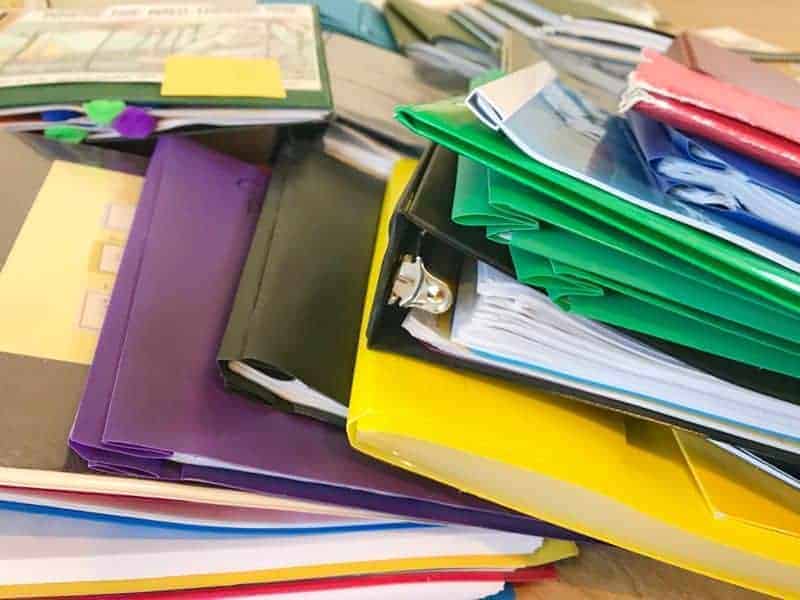
On to the KonMari paper decluttering tips!
Here are a few items I recommend having before you tackle decluttering papers to make your life easier and reduce the stress and mess.
Item 1: A high-quality paper shredder
My paper shredder is the real hero of this story. He made it through about 25 pounds of sensitive document shredding without one hiccup.
If you plan on discarding documents with identifying information on them, credit cards, or other paper that contains information that could be recovered and used fraudulently, please make sure to take the time and shred it before recycling!
Below you can see the actual paper shredder that I used.
This paper shredder made the shredding process very easy,micro-shredding up to 12 sheets at once into super fine pieces.
It is also able to shred credit cards, CDs, and DVDs! Highly recommend.
Update 12/2019 – the paper shredder that I used is no longer available.
Here is the link to the newest model that has been updated for even better performance. All the same features and it shreds up to 15 papers at once!

Item 2: Two or Three Large Plastic Bins
These are going to be labeled “Recycle” and “Shred + Recycle”. You may also want a “Keep” bin.
These bins are going to help keep us from getting overwhelmed by the masses of paper that we are discarding.
As I mentioned before, you will want to be sure and shred any papers with sensitive information (like credit card statements, bank statements, bills, etc) before recycling!
I just used some bins that we had already in our garage (maybe you have some too?) If not, large cardboard boxes could also be used in a pinch.
(I implore you to recycle, rather than just trashing all this paper. You can feel even better about decluttering if you are mindful of the planet at the same time!)

Item 3: Storage methods
These are going to be used to store the very few papers that you decide to keep.
Marie Kondo recommends that your paper storage method should “pursue ultimate simplicity“; use whatever makes sense for your storage system!
We have a filing cabinet that also doubles as a craft storage unit, so I just repurposed three of the filing folders.
You could also use a vertical organization system like the one below that will keep your papers neat and tidy upon your desk.
I think vertical organizers are an attractive option if you are someone like a teacher or fellow speech-language pathologist who needs to keep papers and have them be accessible.
I use this one myself:

Throw it all away!
Just kidding! Well, partially.
Kondo is pretty tough when it comes to paper. In general her philosophy towards paper can be summed up as “Toss it all!”
Obviously, there are papers that are absolutely necessary to keep and maintain for safety and identify purposes.
According to Kondo, there are only three categories of paper that you should not discard.
Those are papers that:
- Need attention – bills to pay, paperwork to submit, forms to sign, etc
- Are needed for short-term – current tax documents, current warranties, etc
- Are needed indefinitely – birth certificates, marriage certificates, social security cards, etc
These are the documents that will be placed into your filing folders for storage, although if you choose to go the command center route, papers that need attention coming in and leaving the house can be stored there.
How to declutter paper with the KonMari method
1. Gather all of your paper and laying it on a broad, flat surface
If you don’t have many papers, you could use a table. I found it easier to place everything on the floor. You can see that I had my bins of notebooks full of papers from school.
Basically, just lay it all out there at once. Have your bins ready for discarding set near you.
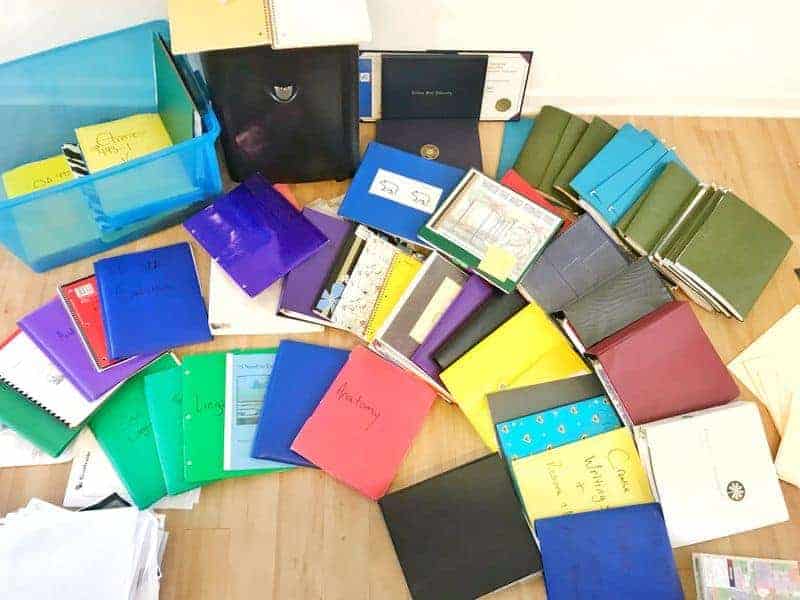
2. Begin sorting
Begin to sort through the papers.
In accordance with the KonMari method, hold each piece of paper in your hand and ask yourself, “Does this spark joy?”.
If not, that item should be discarded.
As you go, place the papers that need to be discarded into the appropriate bins at your side. Sensitive documents will be placed in the Shred + Recycle box.
Documents that don’t contain sensitive information can simply be placed into the Recycle bin.
Optional step: marvel at prehistoric times when you discover a floppy disk!

3. Keep on sorting
Like Dory just keeps swimming, you are going to just keep sorting. You are going to sort, and sort, and sort, until you feel like you can sort no further.
Just keep sorting 🙂
Once you get through all of the papers, then it is time to discard.
It’s okay to take a few moments and reminisce over papers.
I got hung up for a moment on this old invoice to my grandmother for Barbies that she purchased me in 1996.
It brought back the ghosts of Christmas’ past.
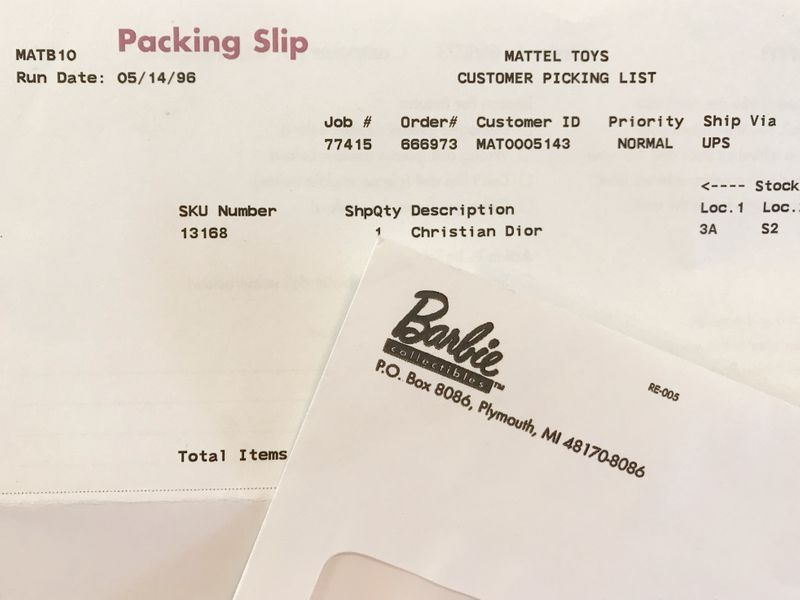
4. Shred and Recycle
Try and recycle the non-sensitive papers right after you finish sorting.
I took mine straight to our recycling center. After that, you will only be left with the bin full of sensitive documents to shred.
The beautiful thing about using bins is that if you run out of time for shredding, you can save that for another day by simply closing up the bins and stowing them away.
This is helpful if you are decluttering while your children are taking a nap, at school, etc.
That little trick was honestly a real time saver for me. Because of the sheer volume of paper, it pretty much took me all day to sort through it and I wasn’t left with enough time to shred.
(Take some breaks if necessary to stretch and rest if you have a lot of paper — don’t get too stiff and stay hydrated!.)
If you do need to set it to the side, make sure you take care of your shredding as soon as possible the following day or after!
Don’t wait too long, or you risk that bin of paper becoming just another pile of clutter left unaddressed!
You can see that my paper shredder reduces the paper into very small pieces, almost like snow! The shredded paper can then be bagged up and taken out for recycling.
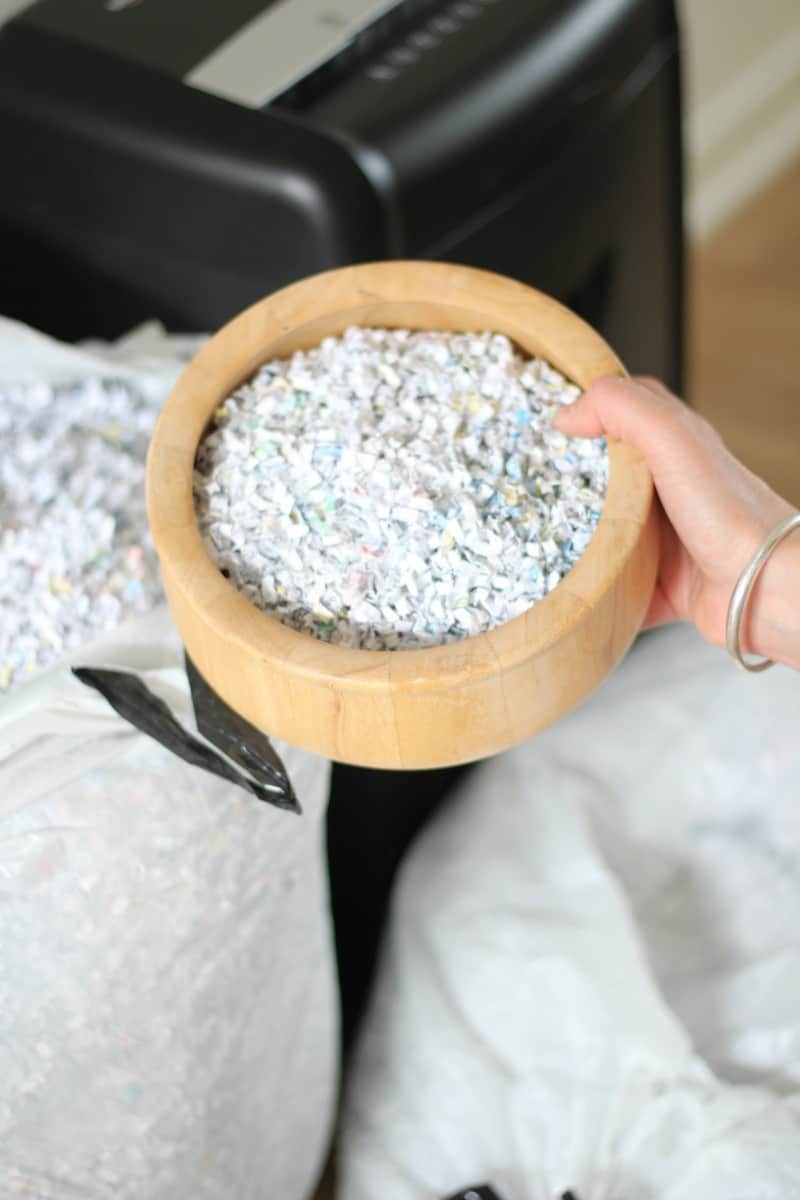
5. Replace those papers that you need to keep
You should be left with a few select paper items that you need to keep.
You can either sort the paper you want to keep by using the KonMari categories (Needs Attention, Need Short-Term, Need Indefinitely) or you could sort them in so that they are arranged in similar categories.
After we finished, we had about 5 filing folders divided by topic: medical documents, identifying documents, etc.
Check out how clean our filing cabinet drawer is now (wish I had taken a “before” picture…it was stuffed to the gills!)

Update: you can read all my other posts about the KonMari method, including:
- Ultimate FREE Printable Comprehensive KonMari Checklist
- 15 KonMari Method Do’s and Don’ts to Tidy Your Entire Life
- KonMari Folding: A Step-by-Step Visual Guide on How to Fold Literally ANYTHING!
- 10 Tips to Joyfully KonMari Your Clothing
- KonMari: Decluttering Books
- KonMari: Decluttering Your Kitchen
- KonMari: Decluttering Toys
Now you are all finished!
Was it easier or harder than you expected? Let me know your paper decluttering experience in the comments section below.
Related posts:
- 7 tips to help you organize paper after decluttering
- 20 genius DIY command centers to help you stay organized
But wait! Don’t leave without signing up for your FREE KonMari checklist.
It has five pages of items listed in all of the KonMari categories so that you don’t miss a single item!
Pin this!

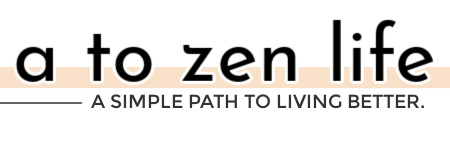
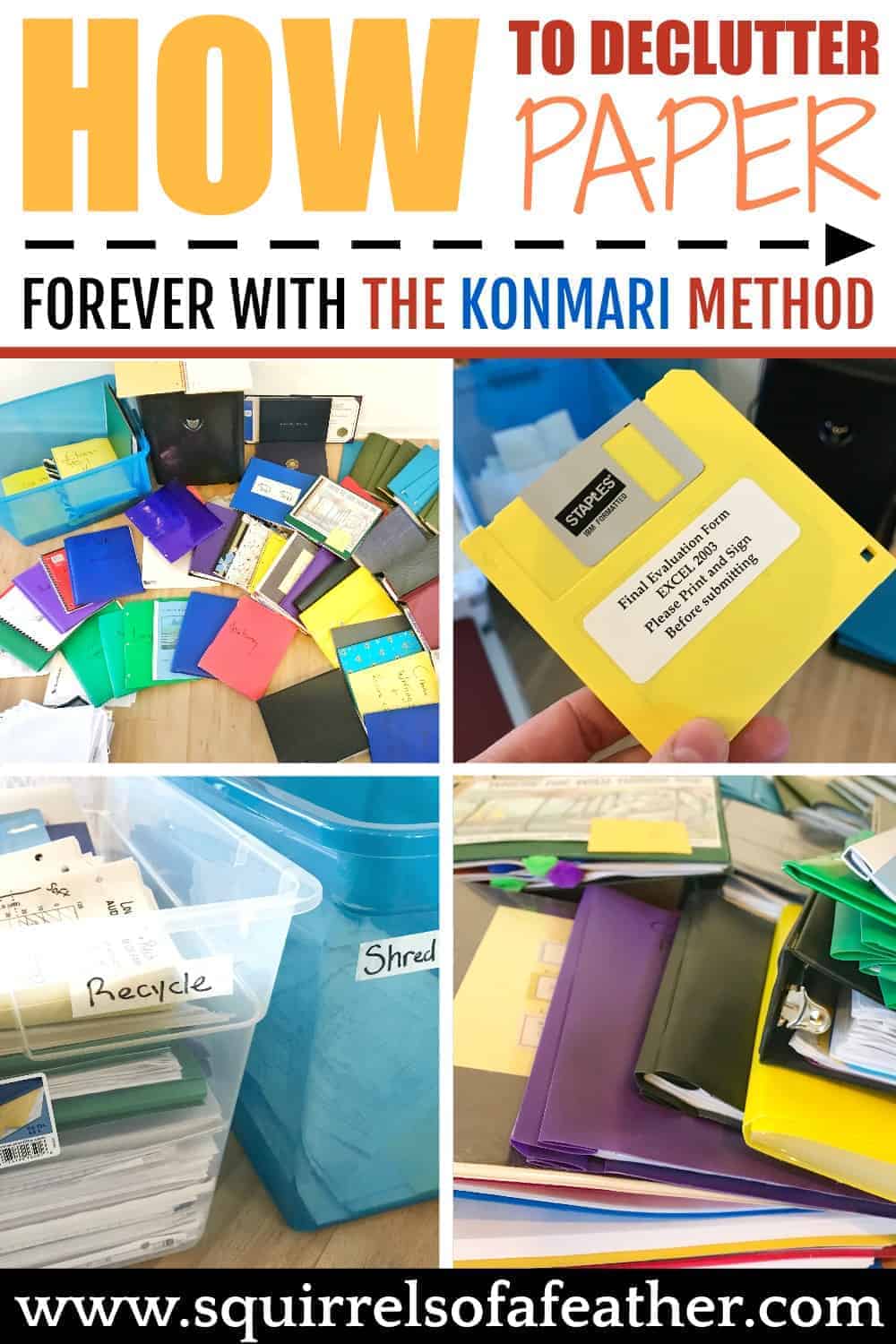


I bet it felt great to get that done. Thanks for those tips. I might need to check into this system for decluttering. Thanks for sharing.
It was hard at the beginning, but truly great once finished!
We have tons of paper! I may need to sit and cry over it and then get rid of it too! Lol! Thank you for sharing on Merry Monday! Hope to see ya next week!
Kim
Kim, it’s totally a cathartic cry! You will be in a better place afterwards for sure. Thanks for coming 🙂
I’m not ready. Insert stressed out woman pulling hair. I am interested .
I think you are never ready, but just need to dive in! Kind of like jumping into a cold pool 🙂
True.
Love your positivity and sense of humor, keep up the good work on the blog girl! I…. am about to start my paper journey. *sighs* Wish me luck.
Best of luck, Aaliyah! Remember, it’s about the journey, not necessarily the goal. 🙂
I’m officially on step “paper” this weekend. After reading the book (several weeks ago) I found myself getting rid of a lot of stuff on my own, so my pile is luckily just a hill instead of a mountain. A big challenge for me is getting stuff done in “one go”. Wish me luck! Thank you for your resources. 🙂
Sarah, you have made it so far! Keep it up, and don’t pressure yourself to do it “in one go” too much…if you use the tips for hiding stuff in bins, it makes it easy to stash a bunch of papers and then come back when you are ready. Definitely, wish you the best of luck!
Tidying all my paper is actually killing me! It’s so true that we become attached to it all because of what it represents, and that it takes conscious thought to realise that our achievements and experiences are only symbolised in these bits of floppy paper.
It was very touching to read of how you worked so hard to fulfil your dad’s hopes for you. It’s really interesting how much I’m learning about myself from tidying…
A great tip is to scan some documents with your phone and store them in a drive in the cloud as PDF’s. Then you can throw out the paper version! This has helped me 🙂
It was truly shocking how hard paper was to declutter! Thank you so much for your kind words! You are right, the Cloud is a GREAT option for storing instead of keeping physical copies. I hope to do a post about paper-free living in the future, in fact. Best of luck in your continued decluttering, I know it’s tough, hang in there!. 🙂
I loved your post thanks!! The problem I have with paper is that I am in education and academics and I need to get more insight into this in terms of academics/ workplace. ..as my home office is my work office too….
Hey Claudine! I hope to share a new post on EXACTLY this topic soon – we just moved overseas and I am working on setting up my own office now at home. Stay tuned (join the newsletter or subscribe to me on YouTube if you want to stay up-to-date). Take care! 🙂
On my, paper and what it represents ! I started digging into family ancestry over a decade ago and historical research took me to place where have so much info in personal journals, not forgetting the gardening chronicle journals and associated research references etc.
I wish I had a magic wand that could scan it all, yet put it all in some sort of order too. A hobby ,interest took on a life of its own. It adds up to years of research. I couldn’t possibly shred it . Friends and family have suggested I write a book or blog so the information is shared or at very least documented in a format that’s used friendly. I don’t know quite where to start. A bit overwhelmed.
My great-grandmother was like that! She passed on the materials to my cousin, and I also know people who have donated such records to local museums — good luck on preserving your hard work with intention!